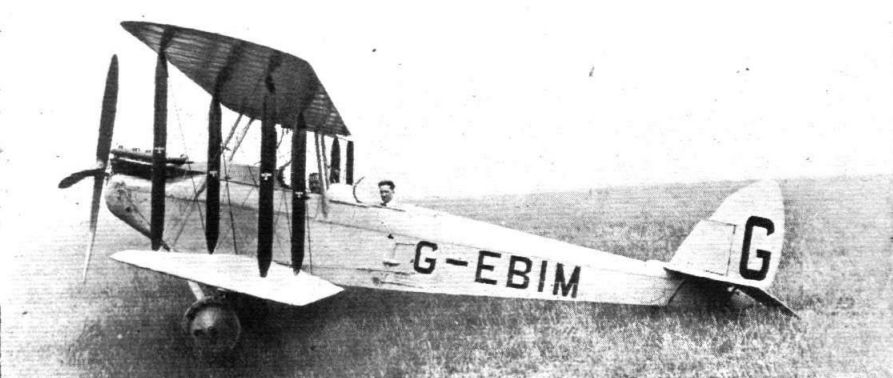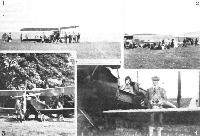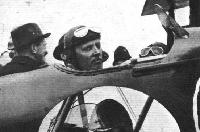
Варианты
- De Havilland - D.H.37 - 1922 - Великобритания
- De Havilland - D.H.51 - 1924 - Великобритания
de Havilland DH.51
После трехместного аэроплана DH.37 де Хэвилленд построил следующую машину этой категории - DH.51. Однако в этом случае главным критерием стала экономичность. Конструкция была разработана на базе рядного мотора RAF 1A мощностью всего 90 л. с. (67 кВт), запасы которых после войны распродавали по очень низким ценам.
DH.51 впервые взлетел в июле 1924 года под управлением самого Джеффри де Хэвилленда. Самолет оценили как вполне удовлетворительный, но из-за системы зажигания двигателя со всего одной свечой на цилиндр, его сочли недостаточно безопасным и отказались выдать сертификат летной годности. Для сертификации требовалось проведение летных испытаний в течение десяти часов непрерывной работы, но де Хэвиллэнд решил, что "игра не стоит свеч". Было решено установить на DH.51 мотор Airdisco. Характеристики аэроплана существенно улучшились, но из-за возросшего расхода топлива самолет стал совсем неэкономичным, то есть его разработка потеряла смысл. В результате собрали только три DH.51. Первые два летали долго и активно, их списали в 1931 и 1933 годах. Третий экземпляр построили в 1925 году и отправили в Кению. Он стал первым гражданским самолетом в этой стране. Во время Второй мировой войны аэроплан разобрали, но каким-то чудом он уцелел. Теперь, после нескольких реставраций, самолет снова оказался в стране своего рождения в коллекции фонда "Shuttleworth Trust" в Олд-Уордене, графство Бедфордшир, и является самой старой летающей машиной фирмы "de Havilland Aircraft Со".
ТАКТИКО-ТЕХНИЧЕСКИЕ ХАРАКТЕРИСТИКИ
de Havilland DH.51
Тип: туристический трехместный аэроплан
Силовая установка: рядный поршневой двигатель Airdisco мощностью 120 л. с. (90 кВт)
Летные характеристики: максимальная скорость 174 км/ч на уровне моря; начальная скороподъемность 293 м/мин; практический потолок 4570 м.
Масса: пустого самолета 609 кг; максимальная взлетная 1016 кг
Размеры: размах крыльев 11,28 м; длина 8,08 м; высота 2,97 м; площадь крыльев 30,19 м2
Описание:
- de Havilland DH.51
- Flight, July 1924
THE DE HAVILLAND TYPE D.H.51
Фотографии
-
Flight 1926-07 / Flight
The King's Cup: Another member of the "D.H." family, the "51," with 120 h.p. "Airdisco" engine.
-
Flight 1924-07 / Flight
Регистрационный номер: G-EBIM [7] THE D.H.51 BIPLANE: Three-quarter front view.
-
Flight 1925-07 / Flight
Регистрационный номер: G-EBIM [7] The D.H.51a with 120 h.p. Airdisco engine has been entered by Air-Commodore J. G. Weir, and will be piloted by Colonel the Master of Sempill
-
Aeroplane Monthly 1982-05 / P.Capon - Stag Lane /Capon's Corner/
Регистрационный номер: G-EBIM [7] D.H.51A G-EBIM at Stag Lane in September 1925. G-EBIM ended its days as a seaplane in Australia as G-AUIM.
-
Flight 1925-07 / Flight
Регистрационный номер: G-EBIM [7] The D.H. 51a, with 120 h.p. Airdisco engine has been entered by "Steve'' Donoghue, and will be piloted by Capt. C. D. Barnard. This machine differs from that entered by Air-Commodore Weir in having one pair of inter-plane struts only.
-
Flight 1925-07 / Flight
Регистрационный номер: G-EBIM [7] THE KING'S CUP: Some of the first day's starters. 2, Donoghue's D.H.51a, C. D. Barnard up.
-
Flight 1924-10 / Flight
Регистрационный номер: G-EBIM [7] The D.H.51 was much in evidence at Lympne piloted by Mr. Barnard, and took up a number of distinguished passengers.
-
Мировая Авиация 103
Регистрационный номер: G-EBIR [5] Самолет по имени "Miss Kenya" с кодом G-EBIR содержится в достойном виде и регулярно летает на авиашоу фонда "Shuttleworth Trust". Впервые после восстановления этот аэроплан взлетел 15 марта 1973 года.
-
Aeroplane Monthly 1981-03 / D.H.51 G-EBIR /Preservation Profile/
Регистрационный номер: G-EBIR [5] -
Aeroplane Monthly 1977-07 / The Queen's Silver Jubilee Air Pageant, White Waltham
Регистрационный номер: G-EBIR [5] The Shuttleworth Collection's D.H.51 three-seater of 1925 is the only survivor of three built. Powered by a 120 h.p. Airdisco engine, it was the first aircraft on the Kenya civil register, as VP-KAA. It returned to Britain in 1965.
-
Aeroplane Monthly 1981-03 / D.H.51 G-EBIR /Preservation Profile/
Регистрационный номер: G-EBIR [5] -
Aeroplane Monthly 1979-04 / Stag Lane /Gone but not forgotten/ (1)
Регистрационный номер: G-EBIR [5] D.H.51 G-EBIR, Miss Kenya, built at Stag Lane in 1925 and photographed 53 years later by AIR PORTRAITS near its Old Warden home.
-
Jane's All the World Aircraft 1980 / Encyclopedia of Aviation - Aircraft A-Z - v3
de Havilland D.H.51.
-
Air Pictorial 1957-01
Регистрационный номер: VP-KAA [3] "Nor age doth wither", an appropriate quotation when applied to this well-preserved D.H.51.
-
Aeroplane Monthly 1981-03 / D.H.51 G-EBIR /Preservation Profile/
Регистрационный номер: VP-KAA [3] -
Aeroplane Monthly 1981-03 / D.H.51 G-EBIR /Preservation Profile/
Регистрационный номер: VP-KAA [3] -
Flight 1925-07 / Flight
THE KING'S CUP: Donoghue's D.H.51A, "Come on, Steve," piloted by C. D. Barnard, and the "Airdisco" Avro (W. H. Perry), waiting for their signal to start.
Другие самолёты на фотографии: Avro Type 548 - Великобритания - 1919
-
Flight 1926-08 / Flight
AN AERIAL TOUR IN SCOTLAND: Col. the Master of Sempill carried out yet another aerial holiday from July 29 to August 7 last. This time !ie flew, with Mrs. Sempill, up in Scotland in Air Commodore J. G. Weir's D.H. 51 (Airdisco). We show above some snaps taken during this tour :- 1. The first aeroplane ever to land at John o'Groats; the D.H. 51 on the edge of the cliff. 2. A tenantry reception given in Col. Sempill's honour at Craigievar Castle. 3. The family butler of Fintray House, Aberdeenshire (Lord Sempill's estate), attended to the stocking of the D.H.51 's larder. 4. Princess Maud, who made her first aeroplane flight, and Lord Carnegie at Elsick House, Aberdeenshire. Col. Sempill covered during his tour approximately 1,600 miles in 18 flying hours.
-
Flight 1927-06 / Flight
THE PRIVATE OWNERS' HANDICAP: The machines are here seen approaching the aerodrome turning point at the conclusion of the second lap. Mr. Norman Jones was so far ahead as to be out of the picture. The others are, in the order given - Longton, on the "Bluebird," de Havilland on "Moth" NO, Col. Sempill on D.H. 51, Hinkler on his "Avian," Lady Bailey on her "Moth," PU, and Scroggs on the Westland "Woodpigeon."
Другие самолёты на фотографии: Avro Avian / Type 594/616 - Великобритания - 1926Blackburn Bluebird / L.1 - Великобритания - 1924De Havilland Moth / D.H.60 - Великобритания - 1925Westland Wood Pigeon - Великобритания - 1924
-
Flight 1925-07 / Flight
THE KING'S CUP CONSOLATION HANDICAP: 1, Colonel the Master of Sempill, who won Friday's miniature King's Cup Race on the D.H.51 entered by Air-Comm. J. G. Weir.
-
Flight 1924-07 / Flight
Side elevation of the D.H.51 showing arrangement of cockpits, seats, controls, &c.
-
Flight 1924-07 / Flight
THE D.H.51: On the left a sketch showing hinged door and sliding cockpit fairing. On the right the rubber-closed slot for the rudder bar.
-
Flight 1924-07 / Flight
D.H.51 90 HP. R.A.F.1A or 80 HP. Renault Engine
- Фотографии























